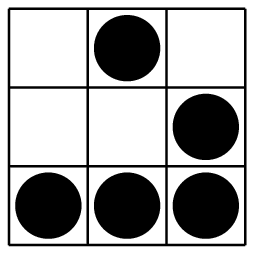17
1
This:
is a Glider.
In Conway's Game of Life, the glider is a famous pattern that rapidly traverses across the board. For today's challenge, we are going to draw an ASCII art Game of Life Board, and place a glider on it.
The board we are starting with is this:
|_|_|_|_|_|_|_|_|_|_|
|_|_|_|_|_|_|_|_|_|_|
|_|_|_|_|_|_|_|_|_|_|
|_|_|_|_|_|_|_|_|_|_|
|_|_|_|_|_|_|_|_|_|_|
|_|_|_|_|_|_|_|_|_|_|
|_|_|_|_|_|_|_|_|_|_|
|_|_|_|_|_|_|_|_|_|_|
|_|_|_|_|_|_|_|_|_|_|
|_|_|_|_|_|_|_|_|_|_|
This board is made up entirely of pipes | and underscores _, and is 10x10. You must write a program or function that takes in two integers, 'x' and 'y', and outputs this same board with a glider at those coordinates. For example, if you had a glider at position (1, 1) (0-indexed), you must output the following:
|_|_|_|_|_|_|_|_|_|_|
|_|_|*|_|_|_|_|_|_|_|
|_|_|_|*|_|_|_|_|_|_|
|_|*|*|*|_|_|_|_|_|_|
|_|_|_|_|_|_|_|_|_|_|
|_|_|_|_|_|_|_|_|_|_|
|_|_|_|_|_|_|_|_|_|_|
|_|_|_|_|_|_|_|_|_|_|
|_|_|_|_|_|_|_|_|_|_|
|_|_|_|_|_|_|_|_|_|_|
You can assume that the glider will never be placed out of bounds, so both x and y will always be in the [0-7] range. You may also choose to take the coordinates 1-indexed, but you must specify this in your answer. In this, case the inputs will always be in the [1-8] range. Here are some examples (all 0-indexed):
0, 0:
|_|*|_|_|_|_|_|_|_|_|
|_|_|*|_|_|_|_|_|_|_|
|*|*|*|_|_|_|_|_|_|_|
|_|_|_|_|_|_|_|_|_|_|
|_|_|_|_|_|_|_|_|_|_|
|_|_|_|_|_|_|_|_|_|_|
|_|_|_|_|_|_|_|_|_|_|
|_|_|_|_|_|_|_|_|_|_|
|_|_|_|_|_|_|_|_|_|_|
|_|_|_|_|_|_|_|_|_|_|
7, 7:
|_|_|_|_|_|_|_|_|_|_|
|_|_|_|_|_|_|_|_|_|_|
|_|_|_|_|_|_|_|_|_|_|
|_|_|_|_|_|_|_|_|_|_|
|_|_|_|_|_|_|_|_|_|_|
|_|_|_|_|_|_|_|_|_|_|
|_|_|_|_|_|_|_|_|_|_|
|_|_|_|_|_|_|_|_|*|_|
|_|_|_|_|_|_|_|_|_|*|
|_|_|_|_|_|_|_|*|*|*|
7, 4:
|_|_|_|_|_|_|_|_|_|_|
|_|_|_|_|_|_|_|_|_|_|
|_|_|_|_|_|_|_|_|_|_|
|_|_|_|_|_|_|_|_|_|_|
|_|_|_|_|_|_|_|_|*|_|
|_|_|_|_|_|_|_|_|_|*|
|_|_|_|_|_|_|_|*|*|*|
|_|_|_|_|_|_|_|_|_|_|
|_|_|_|_|_|_|_|_|_|_|
|_|_|_|_|_|_|_|_|_|_|
5, 2:
|_|_|_|_|_|_|_|_|_|_|
|_|_|_|_|_|_|_|_|_|_|
|_|_|_|_|_|_|*|_|_|_|
|_|_|_|_|_|_|_|*|_|_|
|_|_|_|_|_|*|*|*|_|_|
|_|_|_|_|_|_|_|_|_|_|
|_|_|_|_|_|_|_|_|_|_|
|_|_|_|_|_|_|_|_|_|_|
|_|_|_|_|_|_|_|_|_|_|
|_|_|_|_|_|_|_|_|_|_|
As usual, you may take your IO in any reasonable format. This includes, but is not limited to a string with newlines, an array of strings, a 2d array of strings, or writing to a file/STDOUT. You may also choose what order to take x and y in.
Since this is code-golf, standard loopholes are banned, and make the shortest code that you can!

Can we change which corner identifies the glider's position? – Stephen – 2017-05-31T20:15:35.503
@StephenS No, the coordinates should Identify where the top left corner of the glider starts. – James – 2017-05-31T20:18:42.817
Related. – MD XF – 2017-05-31T20:42:52.223
2
the glider is a famous pattern that slowly traverses across the boar.. Slowly? It is the fastest diagonal moving object in GoL. It reaches 1/4 of the speed of light. – Christoph – 2017-06-01T07:26:04.5901@Christoph, good point,we can observe that it's length does not appear to contract in the direction of travel, but I don't know any way of measuring it's mass at relativistic speeds. – Wossname – 2017-06-01T10:39:28.543